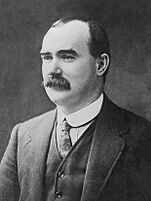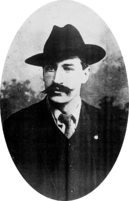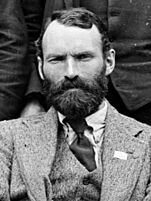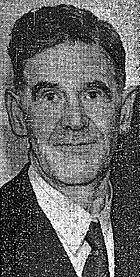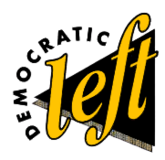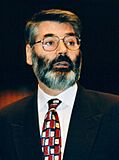Labour Party (Ireland) facts for kids
Quick facts for kids <div style="padding-top:0.3em; padding-bottom:0.3em; border-top:2px solid Lua error in Module:European_and_national_party_data/config at line 227: attempt to index field 'data' (a nil value).; border-bottom:2px solid Lua error in Module:European_and_national_party_data/config at line 227: attempt to index field 'data' (a nil value).; line-height: 1;">
Labour Party
Páirtí an Lucht Oibre
|
|
|---|---|
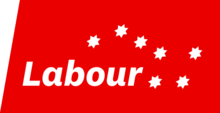 |
|
| Leader | Ivana Bacik |
| Seanad leader | Vacant |
| Parliamentary Party Chairperson | Ged Nash |
| Chairperson | Lisa Connell |
| General Secretary | Billie Sparks |
| Founders |
|
| Founded | 28 May 1912 |
| Headquarters | 2 Whitefriars, Aungier Street, Dublin |
| Youth wing | Labour Youth |
| Women's wing | Labour Women |
| LGBT wing | Labour LGBT |
| Membership (2020) | ~3,000 |
| Ideology | Social democracy Pro-Europeanism |
| Political position | Centre-left |
| European affiliation | Party of European Socialists |
| International affiliation |
|
| European Parliament group | Progressive Alliance of Socialists and Democrats |
| Colours | Red |
| Anthem | "The Red Flag" |
| Dáil Éireann | Lua error in Module:European_and_national_party_data/config at line 227: attempt to index field 'data' (a nil value). |
| Seanad Éireann | Lua error in Module:European_and_national_party_data/config at line 227: attempt to index field 'data' (a nil value). |
| Local government |
56 / 949
|
| European Parliament | Lua error in Module:European_and_national_party_data/config at line 227: attempt to index field 'data' (a nil value). |
| Website | |
| Lua error in Module:European_and_national_party_data/config at line 227: attempt to index field 'data' (a nil value). | |
The Labour Party (in Irish: Páirtí an Lucht Oibre) is a social-democratic political party in the Republic of Ireland. It is a centre-left party, which means it supports social equality and government programs to help people. It was founded on 28 May 1912 in Clonmel, County Tipperary. Its founders were James Connolly, James Larkin, and William O'Brien. They started the party to be the political voice of the Irish Trades Union Congress.
The Labour Party has always been connected to the trade union movement in Ireland. It works to represent the interests of workers in the Dáil (the Irish parliament) and in local government. Unlike many other Irish parties, Labour did not come from the original Sinn Féin party. However, in 1999, it merged with the Democratic Left party, which did have roots in Sinn Féin.
Labour has often been part of coalition governments, where two or more parties rule together. It has been in government eight times, usually with Fine Gael. In total, Labour has spent 25 years in government. This is the third-longest time for any party in Ireland, after Fianna Fáil and Fine Gael.
The party is currently led by Ivana Bacik. As of 2025, it is the fourth-largest party in the Oireachtas (the Irish parliament). It is a member of international groups like the Party of European Socialists.
History of the Labour Party
How the Party Began
James Connolly, James Larkin and William O'Brien started the Irish Labour Party in 1912. It was created to be the political part of the Irish Trades Union Congress. They wanted to represent workers in the new Irish parliament that was expected to be set up.
However, the party faced challenges. The trade unions were weakened after the Dublin Lockout of 1913, a major industrial dispute. Then, James Larkin left the country in 1914, and James Connolly was executed after the Easter Rising in 1916. These events made it hard for the new party to grow.
The Irish Citizen Army (ICA), which was formed during the Lockout, was like the military group for the Labour movement. The ICA took part in the 1916 Rising.
Early Years in the Irish Free State
The Labour Party, led by Thomas Johnson, decided not to take part in the 1918 general election. They wanted the election to be a clear vote on Ireland's future. Because of this, the party was not in the Dáil Éireann during the important years when Ireland was fighting for independence.
After the Anglo-Irish Treaty was signed, the country was divided. In the 1922 election, the Labour Party won 17 seats and became the main opposition party in the Dáil. This meant it was the biggest party that was not in government. Labour pushed the Cumann na nGaedheal government to make more social reforms to help people.
In 1932, the Labour Party supported the first Fianna Fáil government, led by Éamon de Valera. Fianna Fáil had promised social changes that Labour agreed with.
A Split and First Time in Government
In the 1940s, there were arguments inside the Labour Party. Some members were accused of having communist ideas. This led to a split in 1944. Six TDs, led by William X. O'Brien, left to form the National Labour Party. This split weakened the Labour movement.
After the 1948 election, both Labour and National Labour joined the first "Inter-Party Government" with other parties like Fine Gael. This was the first time Labour was part of a government. The leader of National Labour, James Everett, became a minister. In 1950, the National Labour TDs rejoined the Labour Party.
From 1948 to 1951 and 1954 to 1957, Labour was a junior partner in two coalition governments with Fine Gael. The Labour leader, William Norton, was the Tánaiste (deputy prime minister) in both governments.
The 1960s and 1970s
Brendan Corish became the leader of Labour in 1960. He wanted the party to adopt more socialist policies, which focus on equality and public ownership. He famously said, "The seventies will be socialist."
In the 1969 election, Labour's share of the vote went up to 17%, its best result in 50 years. However, the party won fewer seats than before. This made Corish rethink his idea of not joining coalitions. From 1973 to 1977, Labour formed another coalition government with Fine Gael.
The 1980s and 1990s

The 1980s were a difficult time for the party. It was in two more coalition governments with Fine Gael. During this time, the government had to make unpopular cuts to spending on health and other public services. Many people blamed Labour for these cuts.
The 1990s were a much better period for Labour. In 1990, Mary Robinson, who was supported by Labour, was elected President of Ireland. She was the first woman to hold the office and the first non-Fianna Fáil candidate to be elected in many years.
The 1992 election was a huge success. The party's support doubled, and it won 33 seats in the Dáil. This was called the "Spring Tide," named after the party leader, Dick Spring. Labour then formed a coalition government with Fianna Fáil.
Two years later, that government fell apart. Labour then formed a new coalition with Fine Gael and Democratic Left. This was the first time in Irish history that a government was replaced without a general election.
Merger with Democratic Left
In the 1997 election, Labour lost half of its seats. Dick Spring resigned as leader and was replaced by Ruairi Quinn. In 1999, the Labour Party merged with the smaller Democratic Left party. The new, larger party kept the name "Labour Party."
After a poor result in the 2002 election, Quinn resigned. Pat Rabbitte became the new leader.
Recent History (2007–Present)

Eamon Gilmore became leader in 2007. After the Irish economic crisis began in 2008, support for Labour grew quickly. In a 2010 opinion poll, Labour was the most popular party in the country for the first time ever.
In the 2011 election, Labour had its best result ever, winning 37 seats. The party formed a coalition government with Fine Gael. Eamon Gilmore became Tánaiste. Later that year, Labour's candidate, Michael D. Higgins, was elected President of Ireland.
However, being in government during a tough economic time was difficult. The government had to make more unpopular cuts. In the 2014 elections, Labour did poorly, and Gilmore resigned. Joan Burton became the first woman to lead the party.
In the 2016 election, Labour had its worst result in history, winning only 7 seats. Burton resigned, and Brendan Howlin became the new leader.
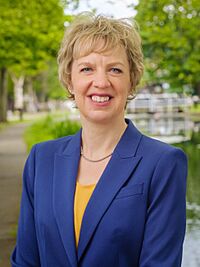
The party's support remained low in the 2020 election, and Howlin stepped down. Alan Kelly was elected leader. In 2021, Ivana Bacik won a by-election, giving the party another seat in the Dáil. In March 2022, Kelly resigned as leader. Ivana Bacik was then elected as the new leader without any opposition.
In the 2024 European Parliament election, Aodhán Ó Ríordáin won a seat for Labour in Dublin. This was the first time the party had won a European seat since 2009.
What the Labour Party Believes In
The Labour Party is a centre-left party that believes in social democracy. This means it supports fairness, equality, and a strong social safety net to help people. The party is also pro-European, meaning it supports Ireland's membership in the European Union.
Over the years, the party's views have changed. In the past, it was more socially conservative and influenced by the Catholic Church. Today, it is known for supporting socially liberal causes.
Social Policies
The Labour Party has a long history of campaigning for equal rights. It was in government in 1993 when laws were changed to give equal rights to same-sex couples. The party also supported laws to outlaw discrimination based on sexual orientation. In 2003, it became the first Irish political party to create an LGBT wing.
The party also supported the campaign to change the law on women's healthcare in 2018. It has called for better rights for workers, including sick pay for everyone.
Other Policies
- Education: Labour wants to make primary school education free by providing grants for books and uniforms.
- Housing: The party has called for building thousands of new social and affordable homes. It also wants to freeze rents to stop them from rising too quickly.
- Health: Labour wants to increase spending on healthcare and provide free GP care for everyone under 18.
- Climate: The party has a plan to fight climate change by cutting the country's carbon emissions in half by 2030. It supports a just transition, which means helping workers and communities as the country moves to a greener economy.
Election results
Dáil Éireann
| Election | Leader | 1st pref votes |
% | Seats | ± | Government |
|---|---|---|---|---|---|---|
| 1922 | Thomas Johnson | 132,565 | 21.3 (#3) |
17 / 128
|
Opposition | |
| 1923 | 111,939 | 10.6 (#4) |
14 / 153
|
Opposition | ||
| Jun 1927 | 143,849 | 12.6 (#3) |
22 / 153
|
Opposition | ||
| Sep 1927 | 106,184 | 9.1 (#3) |
13 / 153
|
Opposition | ||
| 1932 | Thomas J. O'Connell | 98,286 | 7.7 (#3) |
7 / 153
|
Confidence and supply | |
| 1933 | William Norton | 79,221 | 5.7 (#4) |
8 / 153
|
Confidence and supply | |
| 1937 | 135,758 | 10.3 (#3) |
13 / 138
|
Confidence and supply | ||
| 1938 | 128,945 | 10.0 (#3) |
9 / 138
|
Opposition | ||
| 1943 | 208,812 | 15.7 (#3) |
17 / 138
|
Opposition | ||
| 1944 | 106,767 | 8.8 (#4) |
8 / 138
|
Opposition | ||
| 1948 | 115,073 | 8.7 (#3) |
14 / 147
|
FG–LP–CnP–CnT–NLP | ||
| 1951 | 151,828 | 11.4 (#3) |
16 / 147
|
Opposition | ||
| 1954 | 161,034 | 12.1 (#3) |
19 / 147
|
FG–LP–CnT | ||
| 1957 | 111,747 | 9.1 (#3) |
12 / 147
|
Opposition | ||
| 1961 | Brendan Corish | 136,111 | 11.6 (#3) |
16 / 144
|
Opposition | |
| 1965 | 192,740 | 15.4 (#3) |
22 / 144
|
Opposition | ||
| 1969 | 224,498 | 17.0 (#3) |
18 / 144
|
Opposition | ||
| 1973 | 184,656 | 13.7 (#3) |
19 / 144
|
FG–LP | ||
| 1977 | 186,410 | 11.6 (#3) |
17 / 148
|
Opposition | ||
| 1981 | Frank Cluskey | 169,990 | 9.9 (#3) |
15 / 166
|
FG–LP minority | |
| Feb 1982 | Michael O'Leary | 151,875 | 9.1 (#3) |
15 / 166
|
Opposition | |
| Nov 1982 | Dick Spring | 158,115 | 9.4 (#3) |
16 / 166
|
FG–LP | |
| 1987 | 114,551 | 6.4 (#4) |
12 / 166
|
Opposition | ||
| 1989 | 156,989 | 9.5 (#3) |
15 / 166
|
Opposition | ||
| 1992 | 333,013 | 19.3 (#3) |
33 / 166
|
FF–LP (1992–1994) | ||
| FG–LP–DL (1994–1997) | ||||||
| 1997 | 186,044 | 10.4 (#3) |
17 / 166
|
Opposition | ||
| 2002 | Ruairi Quinn | 200,130 | 10.8 (#3) |
20 / 166
|
Opposition | |
| 2007 | Pat Rabbitte | 209,175 | 10.1 (#3) |
20 / 166
|
Opposition | |
| 2011 | Eamon Gilmore | 431,796 | 19.5 (#2) |
37 / 166
|
FG–LP | |
| 2016 | Joan Burton | 140,898 | 6.6 (#4) |
7 / 158
|
Opposition | |
| 2020 | Brendan Howlin | 95,582 | 4.4 (#5) |
6 / 160
|
Opposition | |
| 2024 | Ivana Bacik | 102,457 | 4.6 (#5) |
11 / 174
|
Opposition |
European Parliament
| Election | Leader | 1st pref Votes |
% | Seats | +/− | EP Group |
|---|---|---|---|---|---|---|
| 1979 | Frank Cluskey | 193,898 | 14.48 (#3) |
4 / 15
|
New | SOC |
| 1984 | Dick Spring | 93,656 | 8.36 (#3) |
0 / 15
|
− | |
| 1989 | 155,572 | 9.53 (#4) |
1 / 15
|
SOC | ||
| 1994 | 124,972 | 10.99 (#3) |
1 / 15
|
PES | ||
| 1999 | Ruairi Quinn | 121,542 | 8.73 (#3) |
1 / 15
|
||
| 2004 | Pat Rabbitte | 188,132 | 10.56 (#4) |
1 / 13
|
||
| 2009 | Eamon Gilmore | 254,669 | 13.92 (#3) |
3 / 12
|
S&D | |
| 2014 | 88,229 | 5.33 (#4) |
0 / 11
|
− | ||
| 2019 | Brendan Howlin | 52,753 | 3.14 (#6) |
0 / 13
|
||
| 2024 | Ivana Bacik | 58,975 | 3.38 (#5) |
1 / 14
|
S&D |
See also
 In Spanish: Partido Laborista (Irlanda) para niños
In Spanish: Partido Laborista (Irlanda) para niños
- History of the Labour Party (Ireland)
- Democratic Left (Ireland)
- Social Democratic and Labour Party (Northern Ireland)


